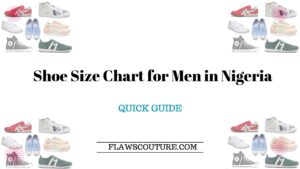In the bustling streets of Lagos to the serene corners of Abuja, the Nigerian fashion scene is vibrant and evolving.
Among the many nuances of fashion, footwear stands out as a pivotal element.
However, when it comes to shoe shopping, especially online, deciphering the right size can be a tad tricky.
This guide aims to simplify the men’s shoe size chart for all the stylish Nigerian men out there.
Why Does Shoe Size Matter?
Before diving into the specifics, let’s address the ‘why’. An incorrectly sized shoe can be more than just an inconvenience. It can lead to foot ailments like blisters, bunions, or even long-term foot deformities.
Therefore, knowing your precise size isn’t just about style; it’s about health and comfort.
The Global Sizing Maze
For the uninitiated, global shoe sizing can feel like navigating a maze. The primary culprits? Different regions have various systems:
- US & Canada
- UK
- Europe (EU)
- Australia
- Japan
But here’s where things become interesting for Nigeria: Nigeria largely follows the UK sizing system, given its historical ties with the UK.
However, due to the influx of global brands, you’ll often find US and EU sizes in Nigerian stores too.
Navigating Men’s Shoe Sizes in Nigeria
Given the predominance of the UK sizing system, here’s a brief conversion chart:
| US Size | UK Size (Nigerian Size) | EU Size | Australia Size | Japan Size |
|---|---|---|---|---|
| 7 | 6.5 | 40 | 6 | 25 |
| 7.5 | 7 | 40-41 | 6.5 | 25.5 |
| 8 | 7.5 | 41 | 7 | 26 |
| 9.5 | 9 | 42 | … | … |
Factors Influencing Shoe Sizes
- Brand Variation: Not all brands size their shoes identically. Always consult the brand-specific size chart when purchasing.
- Material: Shoes made of materials like leather might offer a bit of stretch, while synthetic materials might not.
- Style: A sneaker might fit differently than a formal shoe, even if they are the same size.
Measuring Your Foot at Home
- Materials Needed: Tape measure, flat surface, wall, and a sheet of paper.
- Procedure:
- Place the paper on a flat surface.
- Stand on the paper with your heel against the wall.
- Mark the longest point of your foot on the paper.
- Measure this distance and consult the size chart above to find your size.
Tips for Shoe Shopping in Nigeria
- Know Your Foot Length: Measure your foot in centimeters. This gives you a tangible metric to convert sizes across any system.
- Brand Matters: From ‘Made in Aba’ shoes to international brands in Nigerian malls, there can be slight variations in sizes. Always check brand-specific charts when possible.
- Consider Shoe Type: Traditional leather shoes, loafers, sneakers, and sandals might all fit differently. Keep the shoe type in mind when selecting sizes.
- When in Doubt, Ask: Nigerian vendors, both offline and online, are generally knowledgeable about size conversions. Don’t hesitate to ask if you’re unsure.
ALSO SEE: Trouser Plain and Pattern Styles for Ladies
In Conclusion
The dynamic fashion landscape of Nigeria deserves an informed approach to shoe sizing.
Whether you’re donning a traditional attire or suiting up for a corporate event, the right shoe size can make all the difference.
Here’s to stepping out in style and comfort!

FAQS
1. Why is understanding shoe size important?
- Proper shoe sizing ensures comfort and prevents foot-related health issues.
2. Does Nigeria have its unique shoe sizing system?
- No, Nigeria predominantly follows the UK sizing system but also uses US and EU sizes due to international brands.
3. How is the UK shoe size different from the US size?
- UK sizes are typically one size smaller than US sizes. For example, a UK 8 is equivalent to a US 9.
4. Are there variations within Nigerian shoe brands?
- Yes, individual brands might have slight variations, so it’s always good to consult brand-specific charts.
5. How often should I measure my shoe size?
- Foot size can change over the years, so it’s recommended to measure every couple of years or if there are noticeable changes.
6. Why do I find both EU and UK sizes in Nigerian stores?
- Due to globalization and the presence of international brands in Nigeria, multiple sizing standards are available.
7. How do I convert my EU shoe size to Nigerian (UK) size?
- Typically, the UK size is about 1 size smaller than the EU size, but always check conversion charts to be sure.
8. Why do different types of shoes fit differently even if they’re the same size?
- Shoe type, material, and design can all influence fit, so always try before you buy.
9. Can I trust online size charts?
- Most reputable brands and online stores provide accurate size charts, but it’s always good to read customer reviews and check return policies.
10. What’s the difference between men’s and women’s shoe sizes in Nigeria?
- Men’s sizes are generally broader and larger than women’s for the same foot length.
11. How can I measure my foot at home?
- Use a ruler, pen, and paper. Stand on the paper, mark the longest points, and measure the length.
12. What shoe size is considered ‘large’ for Nigerian men?
- Anything above a UK size 12 is often considered ‘large’.
13. Can weather affect my shoe size?
- Yes, feet can swell in hot weather, affecting shoe fit.
14. Why does the same shoe size feel different across brands?
- Brand-specific designs, materials, and manufacturing processes can lead to size variations.
15. How do half sizes factor into the shoe size chart?
- Half sizes offer a more precise fit, falling halfway between two whole sizes.
16. Are shoe sizes standardized globally?
- No, different regions have their own sizing systems, leading to discrepancies.
17. Is it advisable to buy shoes without trying them on first?
- If shopping online, ensure there’s a good return policy. Trying shoes on, when possible, is always recommended.
18. Do feet change size with age?
- Yes, feet can flatten and lengthen slightly with age.
19. Why do some shoes only come in whole sizes?
- Some brands or styles prioritize manufacturing whole sizes to streamline production.
20. Are athletic shoes sized differently?
- Athletic shoes often have specific sizing, especially for specialized sports. Always consult the brand’s size chart.
21. How should a well-fitted shoe feel?
- Comfortable with some wiggle room for toes, but not too loose that the foot slips out.
22. Is there a difference between casual and formal shoe sizing?
- The size might remain the same, but the fit can differ due to design and materials.
23. Can shoe inserts affect which size I should buy?
- Yes, if you use orthotics or thick insoles, you might need to go half a size up.
24. Are children’s shoe sizes different from adult sizes?
- Yes, children’s sizes are distinct and transition into adult sizes around age 12-14.
25. Can I use the size of my old shoes to buy new ones?
- It’s a good starting point, but always try on new shoes or consult current size charts.
26. Why is width not often included in size charts?
- Standard sizes often cater to average widths, but some brands do offer width options.
27. How does shoe width affect size?
- If a shoe is too narrow or wide, you might need to adjust your size for comfort.
28. Is there a standard foot shape for which shoes are designed?
- Most shoes cater to an average foot shape, but brands might have slight variations.
29. Why do some shoes stretch with time?
- Materials like leather can stretch slightly with wear, affecting fit.
30. Can I determine shoe size by foot length alone?
- Foot length is the primary metric, but width and arch shape can influence fit.
31. Do high-end brands size shoes differently?
- Some luxury brands might have unique sizing, so always consult their specific charts.
32. Why are there fewer half sizes available?
- Production constraints and demand often lead brands to produce more whole sizes.
33. How does shoe sizing relate to foot health?
- Proper sizing can prevent blisters, bunions, and long-term foot deformities.
34. Can I adjust a shoe that’s slightly large using insoles?
- Yes, insoles can help improve the fit of a slightly oversized shoe.
35. How do boot sizes compare to regular shoe sizes?
- Generally, they’re similar, but design and intended sock thickness can affect fit.
36. Is it okay to buy shoes that are slightly tight, expecting them to stretch?
- It’s risky. While some materials stretch, prolonged wear of tight shoes can harm the feet.
37. Do sandals and flip-flops follow the same size chart?
- Generally, yes, but always check brand-specific charts for variations.
38. Can I get shoes custom-sized in Nigeria?
- Yes, several local artisans and brands offer bespoke shoe-making services.
39. How do I convert women’s sizes to men’s when shopping?
- Typically, there’s a 1.5–2 size difference, with men’s sizes being larger.
40. Can foot shape, like having flat feet, affect the size I should choose?
- Yes, foot anomalies like flat feet or high arches can influence the fit and size.

Leave a Reply